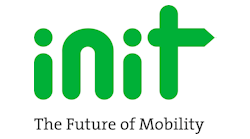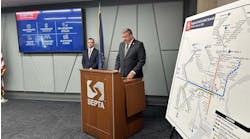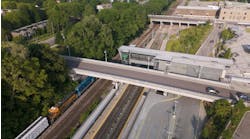Blacksburg,Va.
Tim Witten
ITS Manager
Blacksburg Transit
Data is arguably the most important aspect of our organization, but managing, prioritizing and utilizing it all isn’t simple. Here are five powerful questions that led to powerful results for our organization:
Do you own all of the rights to the data and follow the appropriate processes?” If you don’t own the data, you can’t manipulate and share the data, therefore you have no flexibility to change and adapt to with trends. Too many intelligent transportation systems’ deployments are conducted without a clear understanding of data ownership. We follow the U.S. Department of Transportation's Systems Engineering Process for ITS and make sure that we have full access and rights to data. By doing so, we can prepare for future technology and design, procure and deploy better systems.
How do you decide what stays and what goes? We store all data onsite with remote backups and we keep as much of it as we can. We do this because storage and processing is becoming cheaper, and we want to be prepared for the unknown.
What level of staffing do you need and what do their qualifications need to be? Finding the right person to fill an ITS role is much more important than having a large quantity of people in your division. For example, in a transit data analyst, you need someone who understands transit operations, can communicate effectively and manipulate data from a variety of sources. We’ve been able to hire employees with impressive writing or research backgrounds and then train them on the transit portion of the job.
How do you prioritize the data? Staff time is first dedicated to getting the best possible information to the public. Our ITS team ensures customer-facing systems are functioning properly and providing customers with the information they need. The data that we collect builds our web service, which feeds information into our app, website, texting service and third-party developers’ apps. Since our customers rely on this information, it’s important to ensure everything is working. The data is also used to generate reports for the Federal Transit Administration, state and local stakeholders, and internal operation planning.
Initially our focus was on documenting the report generation processes and automating this when possible. Once this was accomplished, we switched our focus to producing deeper analysis where needed and building additional processes for local data analysis needs. Recently, staff time has been spent building a trip generation model for student-based housing. The housing complexes are hard to handle in existing models, so BT is using historical data in combination with land-use data to predict how changes in bedroom count or service levels may affect ridership.
“Why are you collecting all of this data?” The goal of all data collection is to better educate our customers. If we know exactly where a bus is located, how many people are on the bus, when it will arrive at a certain stop, then why shouldn’t the customer have this information? We collect this data to give customers confidence in navigating our system.
In order to manage, prioritize and utilize all data collected, you need to understand that data takes planning. To reap the benefits of data collection, you need to have a well thought-out plan, appropriate infrastructure and the right staff.
Urbana, Ill.
Andrew Johnson
Chief Operating Officer
Champaign-Urbana Mass Transit District
Data management can mean so many things and is especially challenging for mid-size agencies like Champaign-Urbana Mass Transit District. Given our annual ridership of 12.7 million, we accumulate the same types and volume of data as larger properties and have much of the same technology in place, but we have fewer people to manage, analyze, and apply that data. We’re fortunate to be in a university town, where we’re able to augment our own talent by participating in student projects and hiring interns from the University of Illinois. I like to say we’re small, but mighty.
CUMTD’s commitment to continual improvement dictates that we are always improving processes to utilize as much of the data that our vehicles give us as possible. Tracking our run times, counting passengers, and monitoring dispatching measures are all basic data functions that allow us to overlay real-time adherence with scheduled time points and better optimize our service.
Whether we’re analyzing information to justify a new stop, fix an issue with service delivery, allocate stop amenities, or create easier ways for people to understand and use our system, our planning model is cyclical and constant. We plan, run service, collect data, analyze it, and improve. Then we repeat that process.
In doing so, we are careful to actively seek human input. The human factor is something often overlooked when talking about data analyzation and application and that’s a mistake. Planning needs vary based on community development or redevelopment, local housing patterns and choices, construction patterns, and more, and those factors need a human touch to be properly interpreted. So, for instance, when our larger community enters a multi-year construction project as Champaign-Urbana has recently with CUMTD’s $46.9 million TIGER-funded Multimodal Corridor Enhancement (MCORE) project, we have had to build a model for understanding our ridership data that includes applying a lens of local knowledge to hard numbers.
One of the more creative and compelling things CUMTD does with data is to use our static planning data to supplement the real-time data coming out of our CAD/AVL system. In essence, we are able to pull information from that real-time feed and match it up with static planning data. In this way, we take bare bones real-time data and decorate it with extra information to create a richer experience for our customers via a custom API.
Someday soon, we’ll be able to stand in any community with transit service and ask our phone aloud when the next bus is coming and get a reliable response. Until then, CUMTD’s always looking for creative ways to apply and synthesize the data we collect to both improve our service and offer better ways to create technologies to access it.
Chesapeake, Va.
Iwan Wiens
Statistics Manager
INIT
It is all about the data! That’s what we hear again and again. But, is it just about the data? At INIT, we believe it goes even further than that. Data helps us to understand conditions and find solutions so that we can make the right decisions. INIT’s statistics solution allows you to collect, analyze, and profit from your data.
Managing this process must first start with differentiating between the data and its properties. In order for the data to be useful, specific information such as mileage driven, arrival and departure times, passenger or ticketing counts, and fuel consumption should relate to your route, trip, vehicle, driver, GPS coordinates, and stop or timing points. Once collection and analyzation is accomplished, managing all that information becomes much easier and can then be used to meet your short and long-term goals.
Determining the priority of your data depends on your goals and objectives, or more importantly, your vision. The International Association of Public Transport (UITP) outlines its vision statement by saying, “We are working to enhance quality of life and economic well-being by supporting and promoting sustainable transport in urban areas worldwide.” The emphasis on “quality of life” keeps the focus on what’s important.
Decisions based on data allow you to reach particular goals like on-time punctuality, better headway or service completeness, improved revenue mile costs, or increasing passenger miles. A longer term goal - for example, increasing public transport use by 30 percent in the next 3 years — is then easier to achieve. It stands to reason that smoother operations allow you to offer better service, which increases quality of life for your passengers.
Prioritizing also leads to quality decisions for service enhancements, such as offering free WiFi on public transportation, or providing real-time information tools to keep passengers informed about schedule changes.
Once the priority and goals of the data are defined, you are now able to profit. For instance, driving times can be influenced when the unplanned stops between stations is considered. This leads to simple solutions such as scheduling longer driving time, or more innovative solutions like the introduction of TSP (Traffic Signal Priority) — or even implementing a separate bus line.
Moreover, you can explain long dwelling times at stops when you analyze the passenger exchange at single doors and recognize that most passengers enter the bus through the first door. A simple solution for this would be to schedule a buffer in the driving time, or at the stops. An even better option would be to implement an electronic ticketing system which would save time at stops and allow your drivers to stay focused on their major task of driving.
INIT’s data analytics tool, MOBILEstatistics, automatically loads, analyzes, and evaluates your data to give you the tools you need to make intelligent decisions. The data are presented in easy to understand dashboards, maps, tables and graphs.
In addition to helping transit agencies manage, prioritize, and utilize their data, INIT specialists offer continual support through training on how to work with data to improve operations. Annually, INIT brings customers together for workshops and user group meetings to provide insight and offer more profitability through education and collaboration. In addition, INIT developers release new software versions every three weeks with more improvements and new evaluation features.
So, it’s about what you can do with the data to support sustainable transportation offerings to impact the future of mobility.
Radnor, Penn.
Dr. Edwin Lohmann
Director of Solutions, North America
Quintiq, a Dassault Systemes brand
How do you help transit systems manage, prioritize and utilize all the data coming at them?
So much data is being generated from IT systems, such as those dealing with asset management, passenger counting and train location, but there is often a lack of understanding on how to actually leverage it. As a transit planning and scheduling solution provider, we help transit organizations harness this wealth of information for operational improvement. From Quintiq’s perspective, the important thing about big data isn’t how it gives access to big information – it’s how it can be distilled and processed to make big decisions.
One way we help transit agencies to achieve this is with the use of predictive analytics, which is something we’re increasingly receiving inquiries about. Predictive analytics involves using real-world data to create a feedback loop for improved plans in the future. In the context of a transit organization, it means using input from past performance such as dwell time, maintenance windows and passenger demand to improve future performance automatically over time. With predictive analytics, transit organizations can harness an enormous amount of data, use technology to detect patterns and most importantly directly feed this back into planning and operational disruption management to make better decisions the next time around.
With agencies moving towards real-time information for not only vehicles and rail assets but also passenger counts and demand, all of the data generated from such systems can be used to optimize timetables, rolling stock and crew schedules to best serve passengers. This makes it possible for planners to dynamically adjust rolling stock and crew planning, and manage disruptions based on real-time detailed information from the field. We anticipate that this will increase in the future as agencies get a greater grasp on the many data sources at their disposal.




